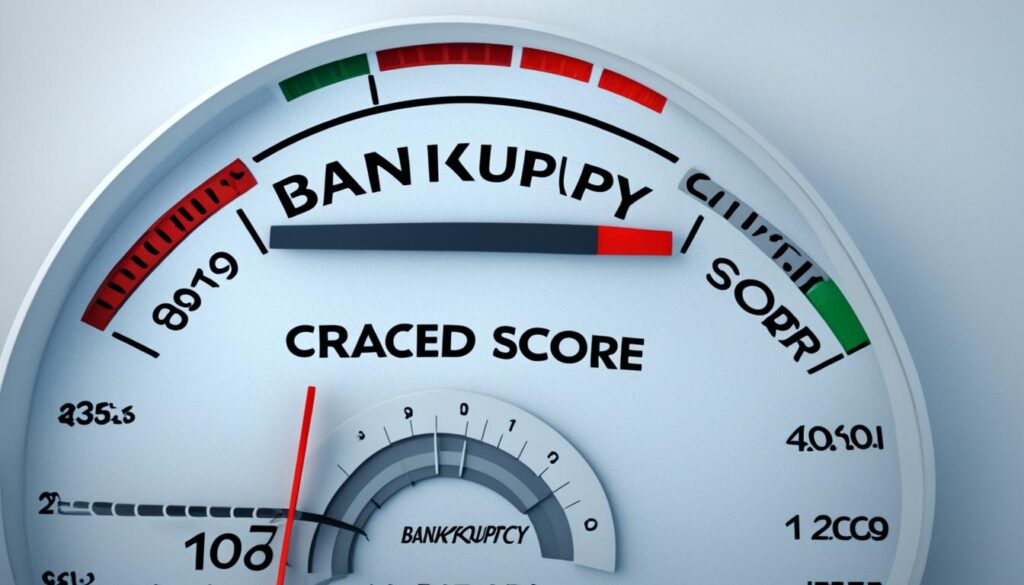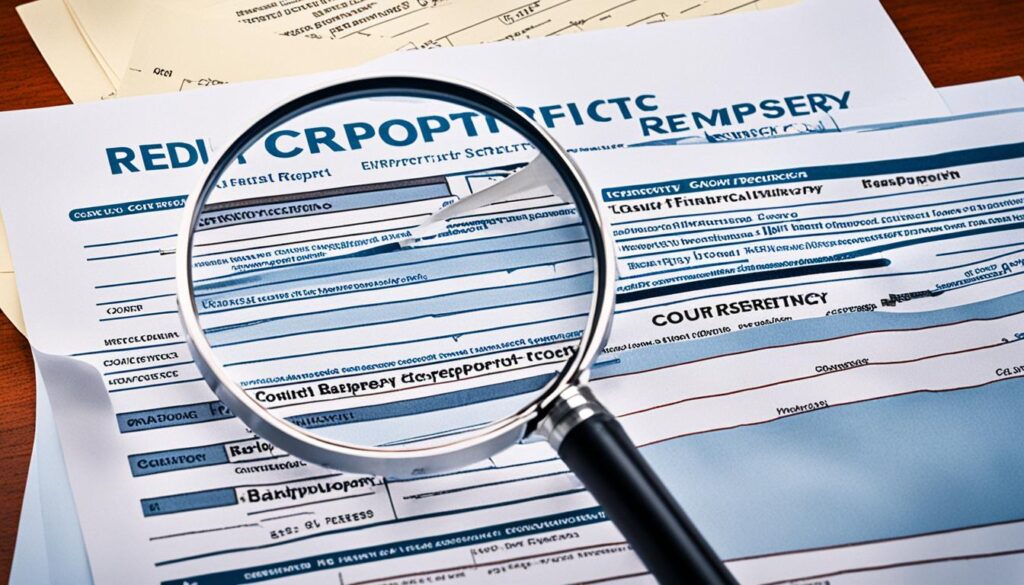Bankruptcy can offer a fresh start, but it leaves a lasting mark on your credit report. Let’s explore ways to dispute bankruptcy entries and tackle credit report errors. We’ll discuss strategies to potentially remove bankruptcy from your credit history.
Handling bankruptcy on your credit report requires care and knowledge. Understanding your rights is crucial when addressing inaccuracies. Knowing how to navigate the dispute process is key to improving your credit score after bankruptcy.
Key Takeaways
- Bankruptcy can significantly impact your credit score
- Credit report errors related to bankruptcy are common
- You have the right to dispute inaccurate information
- Gathering proper documentation is essential for disputes
- Professional credit repair services can provide assistance
- Improving credit post-bankruptcy requires strategic planning
Understanding Bankruptcy on Credit Reports
Bankruptcy leaves a lasting mark on your credit report. It becomes part of your credit history, affecting your financial future. Credit report errors can complicate matters, making credit monitoring essential.
Bankruptcy typically stays on your credit report for 7-10 years. Lenders may view you as a high-risk borrower during this time. Understanding how bankruptcy appears on your report is crucial.
- Type of bankruptcy filed (Chapter 7, 11, or 13)
- Date of filing and discharge
- Debts included in the bankruptcy
Regular credit monitoring helps catch inaccuracies. Address errors promptly to minimize their impact on your credit score. Accurate information can’t be removed before its legal reporting period ends.
“Understanding your credit report after bankruptcy is the first step towards rebuilding your financial health.”
Different types of bankruptcy affect your credit report in various ways:
| Bankruptcy Type | Time on Credit Report | Impact on Credit Score |
|---|---|---|
| Chapter 7 | 10 years | Severe initial drop, gradual recovery |
| Chapter 13 | 7 years | Moderate initial drop, faster recovery |
Knowing how bankruptcy appears on your credit report helps you recover financially. You can better navigate the path to financial recovery and avoid future credit report errors.
The Impact of Bankruptcy on Your Credit Score
Bankruptcy can severely impact your credit score. The effects depend on your financial situation and bankruptcy type. Understanding these implications is vital for your financial future.

Short-term effects
Your credit score may drop by 100 to 200 points after filing. This decrease can limit your access to new credit or loans. Many lenders see bankruptcy as a warning sign.
It becomes challenging to fix credit score quickly. You might face higher interest rates and fewer credit options.
Long-term consequences
Bankruptcy stays on your credit report for 7-10 years. This can affect your ability to get loans or credit cards. Some employers and landlords may view your credit report negatively.
This could impact your job and housing opportunities. Recovery takes time, but it’s not impossible.
Recovery timeline
Many people see credit score improvements within 12-18 months after filing. To speed up recovery, consider these steps:
- Engage in credit counseling to develop better financial habits
- Use secured credit cards responsibly to rebuild credit
- Implement credit monitoring to track progress and catch errors
Patience and consistent effort are crucial for rebuilding credit after bankruptcy. Responsible financial management can lead to a healthier credit profile over time.
Common Errors in Bankruptcy Reporting
Credit report errors can hurt your financial health, especially with bankruptcy. Spotting mistakes is key for removing bankruptcy from credit reports or handling creditor disputes.
Wrong bankruptcy details often cause long-term credit damage. Common errors include wrong dates and misreported account statuses. Outdated info and multiple listings of the same bankruptcy also occur.
These mistakes make rebuilding credit after bankruptcy tough. Check your credit reports often to find any errors.
- Incorrect filing dates
- Misreported account statuses
- Outdated information lingering past legal time limits
- Multiple listings of the same bankruptcy
| Error Type | Potential Impact | Action Required |
|---|---|---|
| Wrong filing date | Extended negative credit impact | Dispute with credit bureaus |
| Misreported account status | Inaccurate credit score calculation | Contact creditors and bureaus |
| Outdated information | Unfair credit score reduction | Request removal from report |
| Duplicate listings | Exaggerated negative impact | File disputes with all bureaus |
Knowing these errors helps you spot issues in your credit report. This knowledge is crucial for boosting your finances after bankruptcy.
Steps to Dispute Bankruptcy on Credit Report
Challenging a bankruptcy on your credit report is a detailed process. It requires careful planning and action. Let’s explore how to tackle inaccuracies in your credit history.
Gather Necessary Documentation
Begin by collecting all relevant paperwork. This includes court documents and correspondence with creditors. Having these ready strengthens your case when you dispute bankruptcy on credit report.
Contact Credit Reporting Agencies
Reach out to Equifax, Experian, and TransUnion separately. You can do this online, by mail, or phone. Credit monitoring services can help track your progress.
File a Formal Dispute
Submit a written dispute to each bureau. Explain the error clearly and provide supporting document copies. Be concise and factual in your explanation.
Follow Up on Your Dispute
After filing, mark your calendar for 30 days. This is how long bureaus typically take to investigate. Stay proactive and follow up if you don’t hear back.

| Step | Action | Timeframe |
|---|---|---|
| 1 | Gather Documents | 1-2 weeks |
| 2 | Contact Agencies | 1-3 days |
| 3 | File Dispute | 1 day |
| 4 | Follow Up | 30-45 days |
Accurate bankruptcy info can’t be removed before its legal reporting period ends. In such cases, focus on rebuilding your credit through positive habits. Credit monitoring can help track your progress.
Legal Rights and Protections for Consumers
The Fair Credit Reporting Act (FCRA) protects consumers with credit report errors and creditor disputes. It ensures your right to accurate credit report information. This includes details about bankruptcy discharge.
The FCRA lets you dispute credit report errors. Credit bureaus must investigate your claim within 30 days. They must fix any errors they find quickly.
“The FCRA empowers consumers to challenge inaccurate information and maintain fair credit reports.”
You have more rights than just disputing errors. You can get free yearly credit reports from major bureaus. You’ll be notified when negative info is added. You’ll get reasons for denied credit applications.
The FCRA also limits credit report access. Employers need your written okay before checking your credit info.
| Consumer Right | Description |
|---|---|
| Dispute Inaccuracies | Challenge errors in credit reports |
| Free Annual Reports | Access reports from major bureaus yearly |
| Information Access | Know who’s viewed your credit report |
| Consent for Employers | Written permission required for checks |
Correct reporting of bankruptcy discharge is vital. If you see errors, act fast. Protect your credit standing and financial future.
Working with Credit Repair Services
Credit repair services can help those with credit score problems. These experts know how to handle credit reports and disputes. They offer valuable help in fixing your credit score.
Pros and Cons of Professional Help
Credit repair services have deep knowledge of credit laws. They can quickly spot errors in your report. However, they can be costly and don’t always guarantee results.
| Pros | Cons |
|---|---|
| Expert knowledge | Can be expensive |
| Time-saving | No guarantee of success |
| Industry connections | Potential for scams |
Choosing a Reputable Service
To safely remove bankruptcy from your credit report, choose a trusted service. Look for companies with good reviews and clear pricing. Avoid those promising quick fixes or overnight miracles.
DIY vs. Professional Credit Repair
DIY credit repair is free but takes time. Professional services save time but cost money. Your choice depends on your situation and financial skills.

Understanding your rights is crucial in credit repair. Services can be helpful, but you can also improve your credit yourself. Consider your options carefully before making a decision.
Strategies for Improving Credit After Bankruptcy
Rebuilding credit after bankruptcy isn’t impossible. With the right approach, you can recover and strengthen your financial standing. Start small and be consistent in your efforts to fix credit score over time.
A secured credit card is a great starting point. These cards need a cash deposit, which becomes your credit limit. Using it wisely shows creditors you’re financially responsible.
Credit counseling offers personalized advice on managing finances. Counselors can create debt management plans tailored to your situation. They guide you through the recovery process.
“Credit counseling helped me understand my finances better. It was a game-changer in my journey to rebuild credit.”
Regular credit monitoring is essential for tracking progress. It helps you spot errors that might slow your credit improvement. Many services provide free credit reports to help you stay informed.
| Strategy | Benefits | Challenges |
|---|---|---|
| Secured Credit Card | Builds credit history | Requires upfront deposit |
| Credit Counseling | Expert guidance | May have associated costs |
| Credit Monitoring | Tracks progress | Requires regular attention |
Improving your credit takes time and patience. Stay committed to your financial goals for positive changes. As you progress, look into advanced credit repair strategies for further financial recovery.
Conclusion
Bankruptcy is tough, but it’s not the end. Learning to dispute bankruptcy on credit report errors is key to rebuilding credit. By addressing mistakes, you can regain control of your finances.
Credit report errors happen. It’s your job to spot and fix them. Correcting inaccuracies, including wrongly reported bankruptcies, helps improve your credit score. Don’t hesitate to contact credit bureaus when needed.
Better credit starts with small steps. Monitor your reports, pay bills on time, and use financial management tools. With effort, you can recover from bankruptcy and build a stronger foundation.
Focus on your goals, and you’ll see gradual improvement. Bankruptcy’s impact lessens over time. Being proactive can speed up your credit recovery. Stay patient and remember that every positive financial move counts.

